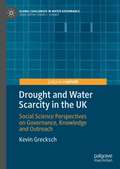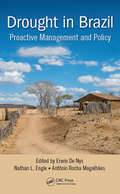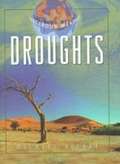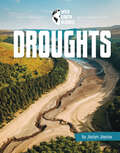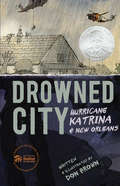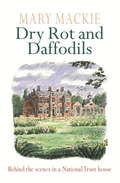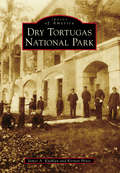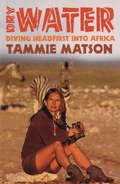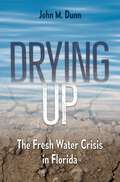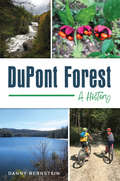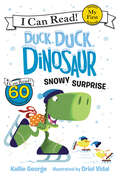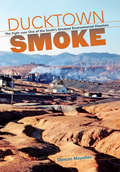- Table View
- List View
Drought and Water Scarcity in the UK: Social Science Perspectives on Governance, Knowledge and Outreach (Global Challenges in Water Governance)
by Kevin GreckschThis book presents a social science perspective on drought and water scarcity in the UK. It puts forward a narrative of how different stakeholders manage drought and water scarcity, how they generate and manage knowledge and how power relationships between stakeholders shape drought and water scarcity management. The book begins with an analysis and critique of all water resources management plans produced by English and Welsh water supply companies for the period 2014-2019 and introduces a novel typology for drought management options. It then moves on to discuss the effect of drought and water scarcity on businesses and production processes as well as how knowledge about drought and water scarcity is generated, by whom and for what purpose. Ultimately the book argues for the urgent need to engage people in the UK about water issues and offers a novel perspective on how to communicate and engage with drought research.
Drought in Brazil: Proactive Management and Policy (Drought and Water Crises)
by Erwin De Nys, Nathan L. Engle & Antônio Rocha MagalhãesDrought is a slow-onset natural hazard that is often referred to as a creeping phenomenon. The challenge of monitoring drought’s onset and evolution, and identifying its termination or end is one that scientists, natural resource managers, and decision makers have been struggling with for decades. However, drought management must be aimed at reducing the risks of future drought events on economies, the environment, and the social fabric of regions. As with many countries, droughts are often managed as a crisis in Brazil, rather than events for which officials and communities proactively prepare. Although droughts are not new to Brazil, the recent spate of droughts in the poverty stricken semi-arid Northeast and the industrial hub of São Paulo in the Southeast has forced the country to think more seriously about finally changing its drought policies and management approaches. The book is told through the perspectives of the ministers and secretaries, state policy and technical officials, civil society organizations, and development practitioners that helped to facilitate the shift in paradigm in Brazil from crisis management and towards proactive management of droughts. It is written in a style that is appealing to both technical and non-technical audiences, and aims to provide a framework and lessons for other countries to consider when embarking upon similar efforts to improve their own drought policy and management systems.
Drought, Risk Management, and Policy: Decision-Making Under Uncertainty (Drought and Water Crises)
by Linda Courtenay Botterill Geoff CockfieldAustralia and the United States face very similar challenges in dealing with drought. Both countries cover a range of biophysical conditions, both are federations that provide considerable responsibility to state governments for water and land management, and both face the challenges in balancing rural industry and urban development, especially in
Drought-Adapted Vine
by Donald Revell"Donald Revell writes with a drunken equipoise among the weedy flowers and bees of roadside museums and vacant churches. . . .[Here] are poems that border the hereafter and revive the child's play of prophecy. What miraculous assistance they provide!"--Dean YoungDonald Revell pushes boundaries between words and music, transcending our current notion of beauty and innocence. Personal memory, the visionary, the eccentric, and the divine intertwine between networks of stories that connect past and present through paint strokes, composition, and pastoral lyric. Pure of heart poems lie down in a vibrant field of paradox, basking gratefully in the sun of unknowing.From "Beyond Disappointment":Hence and farewell valediction: "life's journey."It makes no sense. The children mock us with it.A typewriter beneath the Christmas treeCalls to the icecaps. Illustrated monthliesBurn in the wasps' burnt nest. It isSuch perfections make the sun to rise. Donald Revell has authored eleven collections of poetry, most recently Tantivy (2012) and The Bitter Withy (2009). Winner of the PEN USA Translation Award and two-time winner of the PEN USA Award for Poetry, he has also won the Academy of American Poets' Lenore Marshall Prize and is a former Fellow of the Ingram Merrill and Guggenheim Foundations. Additionally, he has twice been awarded fellowships from the National Endowment for the Arts. Former editor-in-chief of Denver Quarterly, he now serves as poetry editor of Colorado Review. Revell is the director of graduate studies and professor of English at the University of Nevada, Las Vegas.
Drought: An Interdisciplinary Perspective
by Ben CookWater is fundamental to all life. From the Dust Bowl of the 1930s, to the extreme water shortages that have struck California in recent years, modern societies often take its abundance for granted until it unexpectedly becomes scarce. Drought is one of the many problems anthropogenic climate change may exacerbate, but it is also a complex phenomenon at the intersection of a range of scientific disciplines and public policy issues. In this innovative book, Benjamin I. Cook brings together climate science, hydrology, and ecology to provide a synthetic overview of drought and its environmental and social consequences.Cook introduces readers to the hydroclimate and its components, explaining the global water cycle, the earth’s climate system, and the distribution of water resources. He discusses drought dynamics and variability over time, the climatological context and ecological effects, and environmental issues such as desertification, land degradation, and groundwater depletion. He also considers the socioeconomic impacts of drought and the role of drought risk management policy, especially in light of how climate change is expected to affect drought risk and severity. Cook gives special attention to paleoclimate and the role of drought in the crises of ancient civilizations. A scientifically comprehensive and approachable overview of water issues throughout the world, Drought is a critical interdisciplinary text that will be essential reading for a broad range of students in earth science and environmental and sustainability studies.
Droughts (Dangerous Weather)
by Michael AllabyDucks and geese fell from the sky, choked to death by the dust through which they flew. People called the storms "black blizzards." This was the Dust Bowl of the 1930s, site of one of the worst droughts in history. Perhaps the most insidious and terrifying form of dangerous weather, the absence of rain can bring slow, lingering death to crops, animals, and humans. In Droughts readers will discover why ordinary water is the most precious substance on earth; how global climate change might affect the frequency and severity of droughts; how droughts can occur anywhere; and how to use and conserve water wisely. Stories of droughts past and recent are also recounted. The Dangerous Weather series imparts fundamental weather science to readers through author Michael Allaby's vivid descriptions of extreme weather systems. The series focuses on the five most dangerous kinds of weather activity; diagrams related meteorological, climatological, and environmental basics in clear, compelling language; chronicles the history of each form of dangerous weather; and offers safety precautions for extreme weather conditions. Fully illustrated and indexed, the Dangerous Weather series is an invaluable tool for student research. Other volumes include: blizzards, hurricanes, floods, and tornadoes. Michael Allaby is the author of more than 40 books, mainly on science, natural history, ; environmental topics. A few of his previous works include Basics of Environmental Science, How It Works: The Environment, and The Concise Oxford Dictionary of Ecology. He is a member of the New York Academy of Sciences, among other professional affiliations.
Droughts (Let's-Read-and-Find-Out Science 2)
by Melissa StewartRead and find out about droughts in this colorfully illustrated nonfiction picture book.The earth—and everything on it—needs water. But lately, it’s been unusually sunny, warm, and dry. The weather anchor announces that your area is experiencing a drought! Where do droughts happen? How do we know that we are in a drought? Why is rainfall important? Do droughts just affect people? Can scientists keep track of rainfall? Read and find out! This book is full of activities, like how to measure rainfall, how to visualize how much of the world’s water is freshwater, and how to create a cloud in a jar. It’s also full of graphic features perfect for visual learners, like a diagram of the water cycle, and rich vocabulary bolded throughout the text, with a glossary.This is a clear and appealing science book for early elementary age kids, both at home and in the classroom. It's a Level 2 Let's-Read-and-Find-Out, which means the book explores more challenging concepts for children in the primary grades. The 100+ titles in this leading nonfiction series are:hands-on and visualacclaimed and trustedgreat for classroomsTop 10 reasons to love LRFOs:Entertain and educate at the same timeHave appealing, child-centered topicsDevelopmentally appropriate for emerging readersFocused; answering questions instead of using survey approachEmploy engaging picture book quality illustrationsUse simple charts and graphics to improve visual literacy skillsFeature hands-on activities to engage young scientistsMeet national science education standardsWritten/illustrated by award-winning authors/illustrators & vetted by an expert in the fieldOver 130 titles in print, meeting a wide range of kids' scientific interestsBooks in this series support the Common Core Learning Standards, Next Generation Science Standards, and the Science, Technology, Engineering, and Math (STEM) standards. Let's-Read-and-Find-Out is the winner of the American Association for the Advancement of Science/Subaru Science Books & Films Prize for Outstanding Science Series.
Droughts (Wild Earth Science)
by Jaclyn JaycoxDry land. Thirsty plants. When rains don’t come, droughts happen. Desert, forest, or prairies—droughts can happen anywhere. Discover how small shifts in rain amounts can cause big changes to the land. Learn about droughts, what causes them, and how living things adapt to survive.
Droughts: Extreme Weather (Theme Sets)
by Josie GreenDroughts are a form of extreme weather caused by long-term lack of rain in a place that normally gets rain.
Drowned City: Hurricane Katrina and New Orleans
by Don BrownOn August 29, 2005, Hurricane Katrina's monstrous winds and surging water overwhelmed the protective levees around low-lying New Orleans, Louisiana. Eighty percent of the city flooded, in some places under twenty feet of water. Property damages across the Gulf Coast topped $100 billion. One thousand eight hundred and thirty-three people lost their lives. The riveting tale of this historic storm and the drowning of an American city is one of selflessness, heroism, and courage—and also of incompetence, racism, and criminality. Don Brown’s kinetic art and as-it-happens narrative capture both the tragedy and triumph of one of the worst natural disasters in American history. A portion of the proceeds from this book has been donated to Habitat for Humanity New Orleans. <P><P><i>Advisory: Bookshare has learned that this book offers only partial accessibility. We have kept it in the collection because it is useful for some of our members. Benetech is actively working on projects to improve accessibility issues such as these.</i>
Dry
by Neal Shusterman Jarrod Shusterman&“The authors do not hold back.&” —Booklist (starred review) &“The palpable desperation that pervades the plot…feels true, giving it a chilling air of inevitability.&” —Publishers Weekly (starred review) &“The Shustermans challenge readers.&” —School Library Journal (starred review) &“No one does doom like Neal Shusterman.&” —Kirkus Reviews (starred review) When the California drought escalates to catastrophic proportions, one teen is forced to make life and death decisions for her family in this harrowing story of survival from New York Times bestselling author Neal Shusterman and Jarrod Shusterman.The drought—or the Tap-Out, as everyone calls it—has been going on for a while now. Everyone&’s lives have become an endless list of don&’ts: don&’t water the lawn, don&’t fill up your pool, don&’t take long showers. Until the taps run dry. Suddenly, Alyssa&’s quiet suburban street spirals into a warzone of desperation; neighbors and families turned against each other on the hunt for water. And when her parents don&’t return and her life—and the life of her brother—is threatened, Alyssa has to make impossible choices if she&’s going to survive.
Dry Rot and Daffodils
by Mary MackieA funny and enlightening account of life in a National Trust house.Perfect for fans of SECRET LIFE OF THE NATIONAL TRUST and ALL CREATURES GREAT AND SMALL"The next time we went down to the cellar we found that the ceiling over the stairs had collapsed in a welter of dust, cobwebs and ancient lath and plaster. I had wondered why our stairs were more draughty than usual..."If you thought living in a stately home was all gleaming banisters, visiting aristocracy and priceless antiques, then Dry Rot and Daffodils is a must-read. Throughout her years living at Felbrigg Hall in Norfolk Mary Mackie has encountered dry rot, leaking roofs, visiting children who leave bubble-gum on the antiques - and a complete lack of privacy.Full of anecdotes that are always enlightening, often funny and sometimes almost unbelievable, Dry Rot and Daffodils is a wonderfully entertaining account of what it's really like to live in a National Trust house.
Dry Rot and Daffodils
by Mary MackieA funny and enlightening account of life in a National Trust house.Perfect for fans of SECRET LIFE OF THE NATIONAL TRUST and ALL CREATURES GREAT AND SMALL"The next time we went down to the cellar we found that the ceiling over the stairs had collapsed in a welter of dust, cobwebs and ancient lath and plaster. I had wondered why our stairs were more draughty than usual..."If you thought living in a stately home was all gleaming banisters, visiting aristocracy and priceless antiques, then Dry Rot and Daffodils is a must-read. Throughout her years living at Felbrigg Hall in Norfolk Mary Mackie has encountered dry rot, leaking roofs, visiting children who leave bubble-gum on the antiques - and a complete lack of privacy.Full of anecdotes that are always enlightening, often funny and sometimes almost unbelievable, Dry Rot and Daffodils is a wonderfully entertaining account of what it's really like to live in a National Trust house.
Dry Tortugas National Park (Images of America)
by James A. Kushlan Kirsten HinesIsolated 70 miles west of Key West, the islands of Dry Tortugas National Park appear to arise as if by magic, floating atop the waters of the Gulf of Mexico. Discovered by Juan Ponce de León over 500 years ago, Tortugas is North America’s second-oldest persistent place name. The adjacent Florida Strait provided essential passageway for navies, ships of commerce, pirates, and privateers. Its reefs claimed hundreds of ships over the centuries. The nation’s largest masonry fort, Fort Jefferson, secured Union control of the Florida Strait during the Civil War and served as the infamous prison for Dr. Samuel Mudd and other convicted Lincoln conspirators. Its waters, coral reefs, and aquatic life remain among the most biologically intact in North America. Seabird species nest here that nest nowhere else on the continent. The Tortugas has attracted generations of naturalists, scientists, fishermen, divers, birders, and other visitors. The islands and waters of the Dry Tortugas remain today remote, historic, and biologically pristine.
Dry Water: Diving Headfirst into Africa
by Tammie MatsonWhen she was fifteen, Tammie Matson went on safari with her father to Zimbabwe - and it changed her forever. Back in Australia she turned her life upside down to build her future in Africa. Returning to the safari camps - this time as a worker - she out-ran a charging lioness, played with a cheetah, stumbled across poachers and watched with amazement as a witchdoctor struck fear into his victims' hearts. This was the adventure she was looking for and deciding to study zoology gave her a reason to stay. When the Zimbabwean war vets grew too threatening, Tammie headed to the Etosha National Park in Namibia. In that harsh, dry, devastatingly beautiful land, she has overcome the language barrier, the male-dominated society and the physical hardships to create a life she loves.
Drying Up: The Fresh Water Crisis in Florida
by John M. DunnAmerica’s wettest state is running out of water. Florida—with its swamps, lakes, extensive coastlines, and legions of life-giving springs—faces a drinking water crisis. Drying Up is a wake-up call and a hard look at what the future holds for those who call Florida home. Journalist and educator John Dunn untangles the many causes of the state’s freshwater problems. Drainage projects, construction, and urbanization, especially in the fragile wetlands of South Florida, have changed and shrunk natural water systems. Pollution, failing infrastructure, increasing outbreaks of toxic algae blooms, and pharmaceutical contamination are worsening water quality. Climate change, sea level rise, and groundwater pumping are spoiling freshwater resources with saltwater intrusion. Because of shortages, fights have broken out over rights to the Apalachicola River, Lake Okeechobee, the Everglades, and other important watersheds. Many scientists think Florida has already passed the tipping point, Dunn warns. Drawing on more than one hundred interviews and years of research, he affirms that soon there will not be enough water to meet demand if “business as usual” prevails. He investigates previous and current restoration efforts as well as proposed future solutions, including the “soft path for water” approach that uses green infrastructure to mimic natural hydrology. As millions of new residents are expected to arrive in Florida in the coming decades, this book is a timely introduction to a problem that will escalate dramatically—and not just in Florida. Dunn cautions that freshwater scarcity is a worldwide trend that can only be tackled effectively with cooperation and single-minded focus by all stakeholders involved—local and federal government, private enterprise, and citizens. He challenges readers to rethink their relationship with water and adopt a new philosophy that compels them to protect the planet’s most precious resource.
Drylands Facing Change: Interventions, Investments and Identities (Earthscan Studies in Natural Resource Management)
by Angela Kronenburg García, Tobias Haller, Han van Dijk, Cyrus Samimi, Jeroen WarnerThis edited volume examines the changes that arise from the entanglement of global interests and narratives with the local struggles that have always existed in the drylands of Africa, the Middle East, and Central Asia and Inner Asia. Changes in drylands are happening in an overwhelming manner. Climate change, growing political instability, and increasing enclosures of large expanses of often common land are some of the changes with far-reaching consequences for those who make their living in the drylands. At the same time, powerful narratives about the drylands as ‘wastelands’ and their ‘backward’ inhabitants continue to hold sway, legitimizing interventions for development, security and conservation, informing re-emerging frontiers of investment (for agriculture, extraction, infrastructure), and shaping new dryland identities. The chapters in this volume discuss the politics of change triggered by forces as diverse as the global land and resource rush, the expansion of new Information and Communication Technologies, urbanization, the COVID-19 pandemic, and the spread of violent extremism. While recognizing that changes are co-produced by differently positioned actors from within and outside the drylands, this volume presents the dryland’s point of view. It therefore takes the views, experiences, and agencies of dryland dwellers as the point of departure to not only understand the changes that are transforming their lives, livelihoods, and future aspirations, but also to highlight the unexpected spaces of contestation and innovation that have hitherto remained understudied. This edited volume will be of much interest to students, researchers and scholars of natural resource management, land and resource grabbing, political ecology, sustainable development and drylands in general.
DuPont Forest: A History (Natural History)
by Danny BernsteinDuPont Forest protects thousands of acres of trees, five lakes and more than one hundred miles of multiuse trails. It attracts hikers, equestrians and mountain bikers from all over the United States, and its six waterfalls have been featured in movies like The Hunger Games and The Last of the Mohicans. All of this natural beauty is easily accessible, increasing its appeal. It took not only the generosity of a multinational company but also Southern Appalachian grit and self-reliance and local activism to make these benefits available to all. DuPont Forest is young, and its future is still unfolding. Author and hiker Danny Bernstein traces the past of DuPont State Recreational Forest and shows its potential.
Duck & Goose Find a Pumpkin (Duck & Goose)
by Tad HillsDuck and Goose, where is your pumpkin? Is it in the log? Is it under the leaves? Is it in the apple tree? Preschoolers will surely enjoy going on a pumpkin hunt with Duck and Goose . . . especially when they find the perfect pumpkin at the end!
Duck & Goose Go to the Beach: Read & Listen Edition (Duck & Goose)
by Tad HillsIn this delightful follow-up to the New York Times bestselling Duck & Goose and Duck, Duck, Goose, Duck wants to go on an adventure. Goose doesn't. He doesn't see the point. After all, why would they go anywhere when they're happy right where they are? But then Goose sees the ocean and loves it. Who doesn't? Well, Duck, for one!This Read & Listen edition contains audio narration.
Duck & Goose, Here Comes the Easter Bunny! (Duck & Goose)
by Tad HillsDuck & Goose are back! New York Times bestselling author and illustrator Tad Hills brings our favorite feathered friends out to celebrate spring in this sturdy board book. Duck & Goose have lots of ideas about how to find the Easter Bunny, but will they succeed? Preschoolers won't be able to resist this latest board book featuring Duck & Goose, lots of colorful eggs, and the Easter Bunny.From the Board edition.
Duck & Goose, It's Time for Christmas! Read & Listen Edition (Duck & Goose)
by Tad HillsCelebrate Christmas with Duck and Goose's new holiday book, complete with Read & Listen narration! Our feathered friends are getting ready for Christmas. The only problem? Goose is more interested in skating, sledding, and making snow angels than in helping Duck decorate their Christmas tree. While Goose has the time of his life in the snow, it seems poor Duck will be left to do all the work. . . . Tad Hills's simple text and vivid, expressive illustrations make this sweet, funny little book the perfect stocking stuffer. Preschoolers who loved the bestselling Duck & Goose Find a Pumpkin—or those meeting Duck and Goose for the first time—will be thrilled to own this charming winter tale.This ebook includes Read & Listen audio narration.
Duck, Duck, Dinosaur: Snowy Surprise (My First I Can Read)
by Kallie GeorgeWhat could be more fun than a snow day?But Feather and Flap are too cold to play outside with Spike. To keep them outside, Spike surprises them with gifts—skates, a sled, and a snowman. When these aren’t enough to keep his siblings from shivering, Spike comes up with the best gift of all: warm scarves and hats!Playing in the snow with your family can be cool, but thoughtfulness toward others makes playtime a blast for everyone.Duck, Duck, Dinosaur: Snowy Surprise is a My First I Can Read book, which means it’s perfect for shared reading with a child.
Ducktown Smoke: The Fight Over One of the South's Greatest Environmental Disasters
by Duncan MaysillesIt is hard to make a desert in a place that receives sixty inches of rain each year. But after decades of copper mining, all that remained of the old hardwood forests in the Ducktown Mining District of the southern Appalachian Mountains was a fifty-square mile barren expanse of heavily gullied red hills--a landscape created by sulfur dioxide smoke from copper smelting and destructive logging practices. In Ducktown Smoke, Duncan Maysilles examines this environmental disaster, one of the worst the South has experienced, and its impact on environmental law and Appalachian conservation. Beginning in 1896, the widening destruction wrought in Tennessee, Georgia, and North Carolina by Ducktown copper mining spawned hundreds of private lawsuits, culminating in Georgia v. Tennessee Copper Co. , the U. S. Supreme Court's first air pollution case. In its 1907 decision, the Court recognized for the first time the sovereign right of individual states to protect their natural resources from transborder pollution, a foundational opinion in the formation of American environmental law. Maysilles reveals how the Supreme Court case brought together the disparate forces of agrarian populism, industrial logging, and the forest conservation movement to set a legal precedent that remains relevant in environmental law today.
